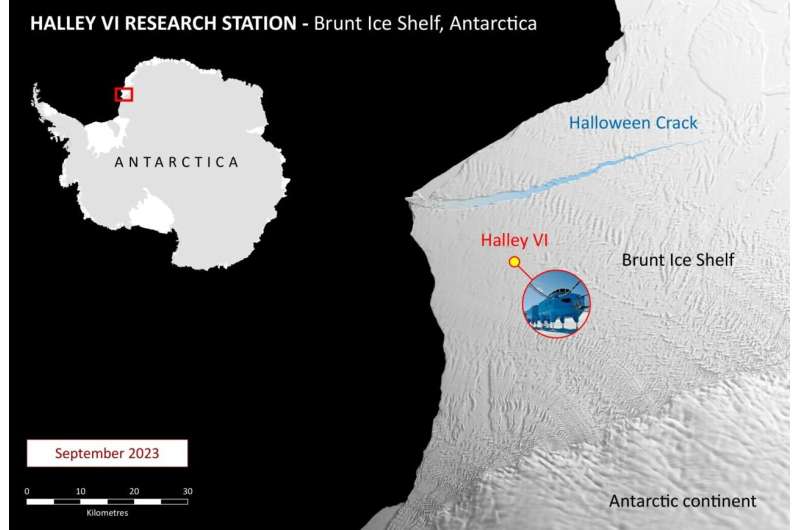This article has been reviewed according to Science X's editorial process and policies. Editors have highlighted the following attributes while ensuring the content's credibility:
fact-checked
peer-reviewed publication
trusted source
proofread
Brunt Ice Shelf speeds up after calving of giant iceberg

Following the calving of the A-81 iceberg at the end of January 2023, the Brunt Ice Shelf is moving faster than before. It is currently moving approximately 4 meters a day towards the sea, whereas before the calving it moved at an average of between 1-2.5 meters a day. The observations have been submitted this week to the journal The Cryosphere.
The Brunt Ice Shelf is one of the most studied ice shelves in the world. Its glaciological structure is complex, and the impact of calving events is often unpredictable. Researchers consider that climate change has not played a significant role in the recent acceleration of the Brunt Ice Shelf. It has accelerated due to the loss of its connection with the seafloor in an area known as the McDonald Ice Rumples, following the calving of the A-81 iceberg.
This connection helped stabilize the ice shelf for most of the last 67 years since it was first occupied and instrumented. The ice shelf is now moving at a rate usually only measured on ice shelves fed by exceptionally fast flowing outlet glaciers such as Thwaites Glacier in West Antarctica.
Scientists at British Antarctic Survey (BAS) are closely monitoring the situation using GPS equipment deployed on the ice and satellite data. The monitoring data are used to aid operational planning at Halley Research Station, which is situated on the most stable part of the Brunt Ice Shelf, 20 km from the new ice front. In 2016, BAS took the precaution of relocating Halley Research Station 23 km inland of the fissure (Chasm-1) that eventually caused the calving of the A-81 iceberg, after it began to widen.
Halley is closed during the Antarctic winter and no staff are currently on station. BAS operations teams are currently planning for a routine field season at Halley with a team of 40 people flying to the Brunt Ice Shelf in November 2023. They will spend the season maintaining the power supplies and facilities that keep the scientific experiments operating remotely through the winter. Their work will continue until they are collected by aircraft in February 2024.
Professor Dominic Hodgson, a BAS glaciologist who is part of the science team that has been studying the Brunt Ice Shelf for over a decade says, "This is a dynamic situation. We expected the ice shelf to respond to the calving of A-81. We are monitoring the acceleration and carrying out further experiments to determine if, and when, the ice shelf will re-establish contact with the sea floor."
"This will be evidenced by a stabilization or decline in ice shelf velocity, which we will be able to record in real time. Our science and operations teams continue to monitor the ice shelf to ensure it is safe, and to maintain the delivery of the science we undertake at Halley."
More information: Oliver J. Marsh et al, Brief Communication: Rapid acceleration of the Brunt Ice Shelf after calving of iceberg A-81, The Cryosphere (2023). DOI: 10.5194/egusphere-2023-1949
Journal information: The Cryosphere
Provided by British Antarctic Survey



















